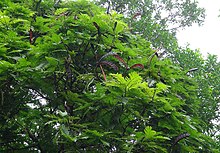| Pentaclethra macroloba | |
|---|---|

| |
| Pentaclethra macroloba tree in Costa Rica | |
| Scientific classification | |
| Kingdom: | Plantae |
| Clade: | Tracheophytes |
| Clade: | Angiosperms |
| Clade: | Eudicots |
| Clade: | Rosids |
| Order: | Fabales |
| Family: | Fabaceae |
| Subfamily: | Caesalpinioideae |
| Clade: | Mimosoid clade |
| Genus: | Pentaclethra |
| Species: | P. macroloba
|
| Binomial name | |
| Pentaclethra macroloba | |
| Synonyms[3][4] | |
|
Acacia macroloba Willd. | |
Pentaclethra macroloba is a large and common leguminous tree in the genus Pentaclethra native to the wet tropical areas of the northern Neotropics, which can form monocultural stands in some seasonally flooded habitats. It has giant, bipinnate leaves shaped like feathers. It uses seed dispersal by water to establish itself in new areas, having floating seeds that are left behind after the waters recede after floods or tides. It has hard timber which is not very resistant to rot in the tropics, but it can be treated, has a pretty pink-red colour when dry, and has a number of uses. Oil used in cosmetics is extracted from the large seeds. In the northern Amazon region the bark is used in herbal medicine as an antivenom, and in the Guianas the bark has been used as a fish poison. Despite their toxicity, the seeds are eaten by variegated squirrels, parrots and macaws, and serve as the nurseries of the larvae of the moth Carmenta surinamensis.
- ^ Botanic Gardens Conservation International (BGCI); IUCN SSC Global Tree Specialist Group (2019). "Pentaclethra macroloba". IUCN Red List of Threatened Species. 2019: e.T62027193A149061882. doi:10.2305/IUCN.UK.2019-2.RLTS.T62027193A149061882.en. Retrieved 25 December 2022.
- ^ Presl, Karel Bořivoj (October 1851). Epimeliae Botanicae. Pragae: Typis Filiorum A. Haase. p. 206. doi:10.5962/bhl.title.61845.
- ^ Flores, E. M. (2002). "Pentaclethra macroloba" (PDF). In J. A. Vozzo (ed.). Tropical Tree Seed Manual. Agricultural Handbook. Vol. 721. Washington, DC: USDA Forest Service. pp. 601–604.
- ^ "Pentaclethra macroloba (Willd.) Kuntze". Plants of the World Online. Royal Botanic Gardens, Kew. 2017. Retrieved 23 May 2021.
